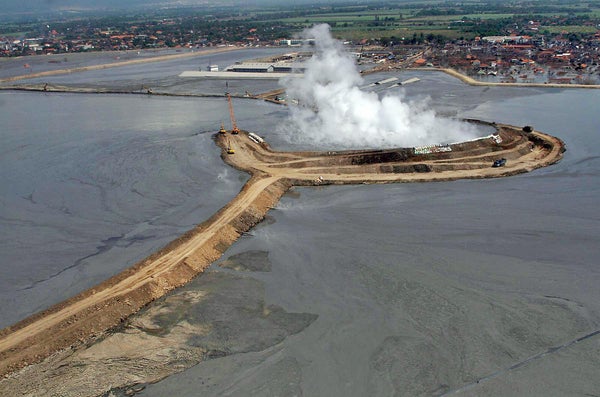In May 2006 boiling mud, gas, water and rock started gushing out of the ground in northeastern Java, one of the islands in the Indonesian archipelago. The massive mud volcano—nicknamed “Lusi”—has continued to spew its hot contents even today, more than 11 years later. Experts say Lusi is the largest mud volcano in the world, now covering seven square kilometers of land. Since 2006 Lusi has dislocated some 60,000 people and caused more than $4 billion in economic damages.
Mud volcanoes are not actual volcanoes—their temperatures are much cooler, and they erupt a mix of rock, clay and mud rather than lava. Some say Lusi is a combination of these two systems, although others debate this. In fact, Lusi remains a mystery to scientists in many ways. One of the biggest and most contentious questions about Lusi concerns what triggered the eruptions: an earthquake or natural gas drilling? Now, in a new study, researchers have imaged the subsurface plumbing system of Lusi. Their work reveals that—regardless of what triggered the eruption—Lusi likely connects at deep depths to a nearby volcanic system.
Several studies had already analyzed the geochemistry of the materials bursting from Lusi. They showed its innards had a volcanic origin, says Adriano Mazzini, a geoscientist at the Center for Earth Evolution and Dynamics at the University of Oslo in Norway. “We could already infer that somehow Lusi and a neighboring volcanic complex are connected at depth,” he says. “What we were missing was a real image of the subsurface that could visually prove this connection between the two.” For the new study, published in October in the Journal of Geophysical Research: Solid Earth, Mazzini and his team installed a large network of seismometers in three areas: Lusi; the volcanic system; and a tectonic fault zone spanning the two. The group then collected 10 months of data from the seismometers and used that information to piece together a picture of the subsurface across these locations.
On supporting science journalism
If you're enjoying this article, consider supporting our award-winning journalism by subscribing. By purchasing a subscription you are helping to ensure the future of impactful stories about the discoveries and ideas shaping our world today.
Their reconstructed image revealed Lusi and the adjacent volcanic system are indeed physically joined via the fault zone. The scientists also discovered hydrothermal fluids—which originate in the volcanic system and feed Lusi—likely migrated vertically from at least six kilometers below the surface. This would mean that, technically, Lusi is not really a straightforward mud volcano. Rather, it is a hybrid structure—half hydrothermal system, half mud volcano.
This strange combination of geologic phenomena formed the hot mud eruption of Lusi, Mazzini says. “If you inject very hot fluids—hydrothermal fluids—into [an area] with sediments rich in organic matter, you’re basically baking this organic matter at very high temperatures. It’s like putting a cake in the oven,” he says. “This will produce [immense] pressure in the subsurface. And at some point, this system will want to come up to the surface. This is what happened with Lusi.”
Some experts who were not part of the research are skeptical about the team’s findings. “I think some of their conclusions are stronger than they can probably justify,” says Michael Manga, a professor of earth and planetary sciences at the University of California, Berkeley. “But it’s an important study because it provides constraints on what’s happening underneath the volcanoes as well as the mud eruptions.”
Richard Davies, a professor of geology at Newcastle University in England, goes further. “I fundamentally disagree with [the researchers’] interpretation,” Davies says, noting that he and Mazzini differ over what triggered the eruption—an earthquake or gas drilling. Davies thinks drilling accidentally caused a huge influx of fluid into a bore hole—the pressure from all that fluid would have become so intense that it fractured surrounding rock, and ultimately resulted in an eruption.
But Stephen Miller, a professor of geodynamics at the University of Neuchâtel in Switzerland, thinks the study’s findings fall in line with what previous research has discovered. “The evidence from the beginning was that this is a natural system,” he says. “This [study] further confirms this is connected—a hydraulic link and thermal link to the volcano.”
The argument over what triggered Lusi has simmered since the eruptions began. Although it might seem like an esoteric scientific debate, there is actually a lot at stake. If drilling set off the eruptions, then the oil and gas company would likely be blamed for the destruction Lusi has caused. The Indonesian government already told the company that it must compensate citizens harmed by the disaster, according to The New York Times.
Mazzini says his study does not—and was not intended—to resolve this fierce debate over the trigger. “From my point of view, it is entirely irrelevant if this was triggered by an earthquake or drilling—this system was prepared naturally, by long and complex geological processes,” he says. “The trigger itself is a very short event, compared to all the rest that happened before. So this eruption would have happened anyhow at some point.”
The team’s research may not only help geologists decipher the Lusi mud eruptions today—it could also help them better understand ancient natural disasters. Earth has experienced enormous, widespread volcanic eruptions in the past, and these may have caused several mass extinctions. Mazzini notes that in addition to the pure volcanic activity, the geologic record seems to show the planet also had hybrid vents very similar to Lusi, if not identical. But instead of just one, there may have been thousands of them—and they would have released volumes of poisonous gases to the surface, possibly helping drive mass extinction. “Of course, all these systems don’t exist anymore today,” he says. “But we were looking for a modern analogue to understand what happened in the past.” And now they have Lusi.
